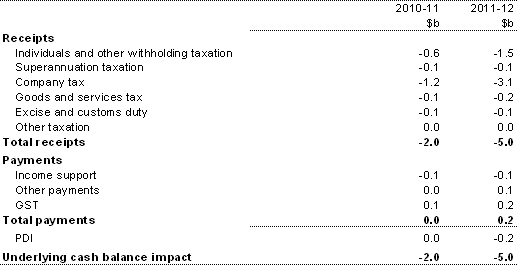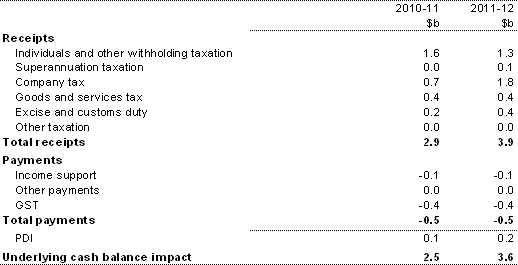The estimates contained in the Pre-Election Economic and Fiscal Outlook 2010 (PEFO) are based on forecasts of the economic outlook. Changes to the economic assumptions underlying the estimates will impact on receipts and payments, and hence the size of the underlying cash balance.
This appendix examines the effects on receipts and payments of altering some of the key economic assumptions underlying the estimates. Tables D2 and D4 illustrate the sensitivity of key components of receipts and payments to possible variations in the economic outlook. The two scenarios considered are:
- Scenario 1: a 1 per cent reduction in nominal GDP owing to a fall in the terms of trade.
- Scenario 2: a 1 per cent increase in real GDP driven by an equal increase in labour productivity and labour force participation.
The economic scenarios provide a rule of thumb indication of the impact on receipts, payments and the underlying cash balance of changes in the economic outlook. They represent a partial economic analysis only and do not attempt to capture all the economic feedback and other policy responses related to changed economic conditions. In particular, the analysis assumes no change in the exchange rate, interest rates or discretionary policy. The impact of the two scenarios on the economic parameters would be different if the full feedback response on economic variables and likely policy actions were taken into account. The analysis does not aim to provide an alternative picture of the economic forecasts under these scenarios, but instead gives an indication of the sensitivity associated with different components of receipts and payments to changes in the economy. As such, the changes in the economic variables and their impact on the fiscal outlook are merely illustrative.
The impacts shown in the tables below are broadly symmetrical. That is, impacts of around the same magnitude, but in the opposite direction, would apply if the terms of trade were to increase or if real GDP were to decrease.
Scenario 1
The first scenario involves a permanent fall in world prices of non-rural commodity exports, which causes a fall in the terms of trade, consistent with a 1 per cent fall in nominal GDP by 2011-12. The sensitivity analysis evaluates the flow-on effects on the economy, the labour market and prices. The impacts in Table D1 are highly stylised and refer to per cent deviations from the baseline levels of the economic parameters.
Table D1: Illustrative impact of a permanent non-rural commodity price fall consistent with
a 1 per cent fall in nominal GDP in 2011-12 (per cent deviation from the baseline level)

Assuming no change in exchange rates or interest rates, the fall in export prices leads directly to a lower non-farm GDP deflator (from the export component of GDP) and lower domestic incomes. Lower domestic incomes cause both consumption and investment to fall, resulting in lower real GDP, employment and wages. The fall in aggregate demand puts downward pressure on domestic prices.
In reality, a fall in the terms of trade would be expected to put downward pressure on the exchange rate, although the magnitude is particularly difficult to model. In the event of a depreciation in the exchange rate, the impacts on the external sector would dampen the real GDP effects, and there would be some offsetting upward pressure on domestic prices.
Given these assumptions, the overall impact of the fall in the terms of trade is a decrease in the underlying cash balance of around $2.0 billion in 2010-11 and around $5.0 billion in 2011-12 (see Table D2).
Table D2: Illustrative sensitivity of the budget balance to a 1 per cent decrease in nominal
GDP due to a fall in the terms of trade

On the receipts side, a fall in the terms of trade results in a fall in nominal GDP which reduces tax collections. The largest impact falls on company tax receipts as the fall in export income decreases company profits. Lower company profits are assumed to flow through to lower Australian equity prices, therefore reducing capital gains tax from individuals, companies and superannuation funds.
The weaker economy results in lower aggregate demand which flows through to lower employment and wages. For this reason, individuals’ income tax collections fall and the decrease in disposable incomes leads to lower consumption, which in turn results in a decrease in GST receipts (decreasing GST payments to the States by the same amount) and other indirect tax collections.
On the payments side, a significant proportion of government expenditure is partially indexed to movements in costs (as reflected in various price and wage measures). Some forms of expenditure, in particular income support payments, are also driven by the number of beneficiaries.
The overall estimated expenditure on income support payments (including pensions and allowances) increases in both years due to a higher number of unemployment benefit recipients. The increase in unemployment benefits in 2011-12 is partly offset by reduced expenditure on pensions and allowances reflecting lower growth in benefit rates resulting from lower wages growth. At the same time other payments linked to inflation fall in line with the reduced growth in prices.
The reduction in the underlying cash balance results in a higher borrowing requirement and a higher public debt interest cost in 2011-12.
As noted above, under a floating exchange rate, the depreciation of the exchange rate would dampen the effects of the fall in the terms of trade on real GDP, meaning the impact on the fiscal position could be substantially more subdued. Also, to the extent that the fall in the terms of trade is temporary rather than permanent, the impact on the economic and fiscal position would be more subdued.
Scenario 2
The second scenario involves a combination of an equal 0.5 per cent increase in the participation rate and in labour productivity, resulting in a 1 per cent increase in real GDP by 2011-12. Once again, the sensitivity analysis evaluates the flow-on effects on the economy, the labour market and prices. The impacts in Table D3 are highly stylised and refer to per cent deviations from the baseline levels of the parameters.
The 1 per cent increase in real GDP increases nominal GDP by slightly less but the magnitude of the effects on receipts, payments and the underlying cash balance differ from the first scenario because this variation in the outlook affects different parts of the economy in different ways.
Table D3: Illustrative impact of an ongoing equal increase in both labour productivity and
participation consistent with a 1 per cent increase in real GDP in 2011-12 (per cent deviation
from the baseline level)

The increase in labour force participation and labour productivity both have the same impact on output, but different impacts on the labour market. Higher productivity leads to higher real GDP and higher real wages, while an increase in the participation rate increases employment and real GDP. Imports are higher in this scenario, reflecting higher domestic incomes.
Since the supply side of
the economy expands, inflation falls relative to the baseline. The fall in domestic prices makes exports more attractive to foreigners, with the resulting increase in exports offsetting higher imports, leaving the trade balance unchanged. The exchange rate is assumed to be constant.
The overall impact of the increase in labour productivity and participation is an increase in the underlying cash balance of around $2.5 billion in 2010-11 and around $3.6 billion in 2011-12 (see Table D4).
Table D4: Illustrative sensitivity of the budget balance to a 1 per cent increase in real GDP
due to an equal increase in both productivity and participation

On the receipts side, individuals’ income tax collections increase because of the rise in the number of wage earners and, additionally, higher real wages. This in turn increases individuals’ refunds in the following year when tax returns are lodged, reducing total individuals’ income tax. The stronger labour market also increases superannuation fund taxes through higher contributions (including compulsory contributions) to superannuation funds. The increase in personal incomes leads to higher consumption which results in an increase in GST receipts (with the corresponding receipts passed on in higher GST payments to the States) and other indirect tax collections.
In addition, the stronger economy results in higher levels of corporate profitability, increasing company taxes. Higher profits are assumed to increase Australian equity prices, generating higher capital gains tax from individuals, companies and superannuation funds.
On the payments side, overall estimated expenditure on income support payments (including pensions and allowances) is slightly higher primarily reflecting growth in benefit rates flowing from higher wages growth. Lower inflation has a partially offsetting effect.
The higher underlying cash balance also has a positive interest impact in both years, owing to a lower borrowing requirement and lower public debt interest cost.
To the extent that the increases in productivity and participation are temporary rather than permanent, the impact on the economic and fiscal position would be more subdued.